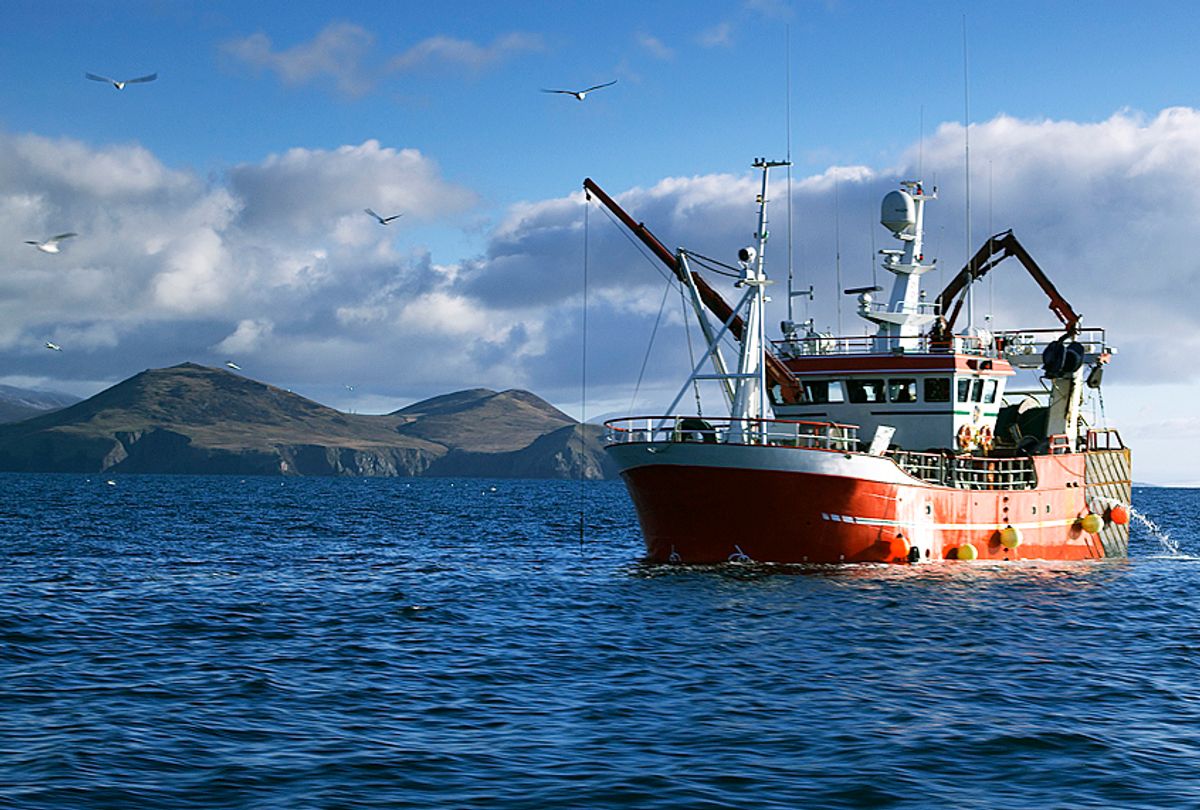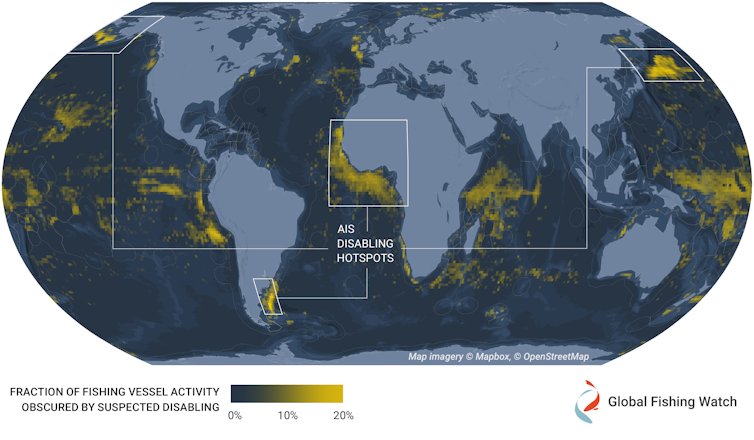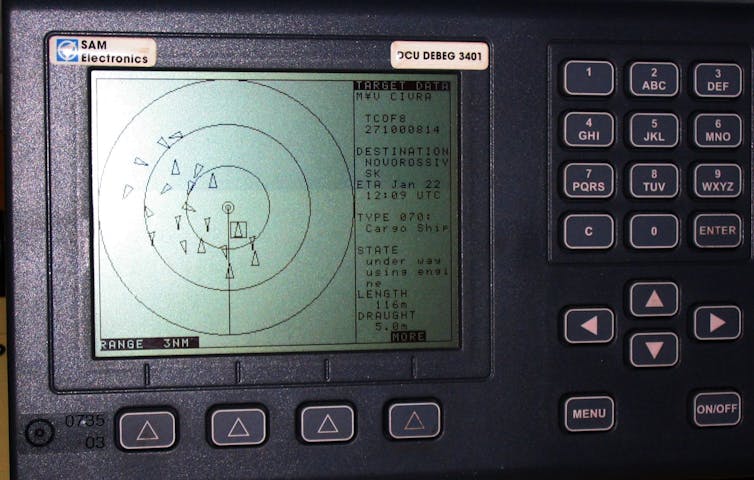In January 2019, the Korean-flagged fishing vessel Oyang 77 sailed south toward international waters off Argentina. The vessel had a known history of nefarious activities, including underreporting its catch and illegally dumping low-value fish to make room in its hold for more lucrative catch.
At 2 a.m. on Jan. 10, the Oyang 77 turned off its location transponder at the edge of Argentina's exclusive economic zone – a political boundary that divides Argentina's national waters from international waters, or the high seas. At 9 p.m. on Jan. 11, the Oyang 77 turned its transponder back on and reappeared on the high seas. For the 19 hours when the ship was dark, no information was available about where it had gone or what it did.
In a recent study, I worked with colleagues at Global Fishing Watch, a nonprofit that works to advance ocean governance by increasing transparency of human activity at sea, to show that these periods of missing transponder data actually contain useful information on where ships go and what they do. And authorities like the International Maritime Organization can use this missing data to help combat illegal activities at sea, such as overfishing and exploiting workers on fishing boats.
Illegal fishing causes economic losses estimated at $US10 billion to $25 billion annually. It also has been linked to human rights violations, such as forced labor and human trafficking. Better information about how often boats go dark at sea can help governments figure out where and when these activities may be taking place.
Countries can combat illegal, unreported and unauthorized fishing by checking paperwork, verifying catches and sharing information across borders.
Going dark at sea
The high seas are the modern world's Wild West – a vast expanse of water far from oversight and authority, where outlaws engage in illegal activities like unauthorized fishing and human trafficking. Surveillance there is aided by location transponders, called the Automatic Identification System, or AIS, which works like the Find My iPhone app.
Just as thieves can turn off phone location tracking, ships can disable their AIS transponders, effectively hiding their activities from oversight. Often it's unclear whether going dark in this way is legal. AIS requirements are based on many factors, including vessel size, what country the vessel is flagged to, its location in the ocean and what species its crew is trying to catch.
A ship that disables its AIS transponder disappears from the view of whomever may be watching, including authorities, scientists and other vessels. For our study, we reviewed data from two private companies that combine AIS data with other signals to track assets at sea. Spire is a constellation of nanosatellites that pick up AIS signals to increase visibility of vessels in remote areas of the world. Orbcomm tracks ships, trucks and other heavy equipment using internet-enabled devices. Then, we used machine learning models to understand what drove vessels to disable their AIS devices.
Examining where and how often such episodes occurred between 2017 and 2019, we found that ships disabled their transponders for around 1.6 million hours each year. This represented roughly 6% of global fishing vessel activity, which as a result is not reflected in global tallies of what types of fish are being caught where.
This map shows the fraction of fishing vessel activity hidden by AIS disabling events from 2017 to 2019. Heavy AIS disabling occurred adjacent to Argentina, West African nations and in the northwest Pacific – three regions where illegal fishing is common. In contrast, the disabling hot spot near Alaska occurs on intensively managed fishing grounds and likely represents vessels going dark to avoid competition with other boats. Global Fishing Watch, CC BY-ND
Vessels frequently went dark on the high-seas edge of exclusive economic zone boundaries, which can obscure illegal fishing in unauthorized locations. That's what the Oyang 77 was doing in January 2019.
Laundering illegal catch
The AIS data we reviewed showed that the Oyang 77 disabled its AIS transponder a total of nine times during January and February 2019. Each time, it went dark at the edge of Argentinean national waters and reappeared several days later back on the high seas.
During the ninth disabling event, the vessel was spotted fishing without permission in Argentina's waters, where the Argentinean coast guard intercepted it and escorted it to the port of Comodoro Rivadavia. The vessel's owners were later fined for illegally fishing in Argentina's national waters, and their fishing gear was confiscated.
AIS disabling is also strongly correlated with transshipment events – exchanging catch, personnel and supplies between fishing vessels and refrigerated cargo vessels, or "reefers," at sea. Reefers also have AIS transponders, and researchers can use their data to identify loitering events, when reefers are in one place long enough to receive cargo from a fishing vessel.
It's not unusual to see fishing vessels disable their AIS transponders near loitering reefers, which suggests that they want to hide these transfers from oversight. While transferring people or cargo can be legal, when it is poorly monitored it can become a means of laundering illegal catch. It has been linked to forced labor and human trafficking.
Valid reasons to turn off transponders
Making it illegal for vessels to disable AIS transponders might seem like an obvious solution to this problem. But just as people may have legitimate reasons for not wanting the government to monitor their phones, fishing vessels may have legitimate reasons not to want their movements monitored.
Many vessels disable their transponders in high-quality fishing grounds to hide their activities from competitors. Although the ocean is huge, certain species and fishing methods are highly concentrated. For example, bottom trawlers fish by dragging nets along the seafloor and can operate only over continental shelves where the bottom is shallow enough for their gear to reach.
Modern-day pirates also use AIS data to intercept and attack vessels. In response, ships frequently disable their transponders in historically dangerous waters of the Indian Ocean and the Gulf of Guinea. Making AIS disabling illegal would leave fishing vessels more vulnerable to piracy.
An AIS-equipped system on board a ship presents the bearing and distance of nearby vessels in a radarlike display format. Clipper/Wikipedia, CC BY
Instead, in my view, researchers and maritime authorities can use these AIS disabling events to make inferences about which vessels are behaving illegally.
Our study reveals that AIS disabling near exclusive economic zones and loitering reefers is a risk factor for unauthorized fishing and transshipments. At sea, real-time data on where vessels disable their AIS transponders or change their apparent position using fake GPS coordinates could be used to focus patrols on illegal activities near political boundaries or in transshipment hot spots. Port authorities could also use this information onshore to target the most suspect vessels for inspection.
President Joe Biden signed a national security memorandum in 2022 pledging U.S. support for combating illegal, unreported and unregulated fishing and associated labor abuses. Our study points toward a strategy for using phases when ships go dark to fight illegal activities at sea.
Heather Welch, Researcher in Ecosystem Dynamics, University of California, Santa Cruz
This article is republished from The Conversation under a Creative Commons license. Read the original article.





Shares